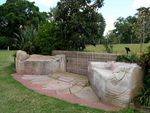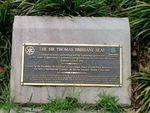
Sir Thomas BrisbanePrint Page 
The seat presented to the people of Queensland by Rotary International commemorates the part Sir Thomas Brisbane played in the history of Queensland.
Sir Thomas Brisbane was 48 when he first landed in Sydney to take over as Governor of the 33 year old colony of New South Wales in 1821 a post he held until 1825. In 1823 Brisbane sent Lieutenant John Oxley to find a new site for convicts who were repeat offenders. Oxley discovered a large river flowing into Moreton Bay. A year later, the first convicts arrived at Moreton Bay. Brisbane visited the settlement in 1826 and came ashore on the Brisbane River in the area where the Romma Street Parklands is situated.
Oxley suggested that both the river and the settlement be named after Brisbane. The convict settlement was declared a town in 1834 and opened to free settlement in 1839.
The budget for a Sir Thomas Brisbane was very limited and so Dr Rhyl Hinwood chose to use demolition stone such as the flagstones and central ‘wall’ that was once the base of a huge sandstone block used in the monumental works as a bed beneath the gang saws that cut many many blocks to different dimensions. Hence the parallel lines intersecting as each job was placed upon it prior to cutting. The gang saws might number about ten in tandem.
The seat is sited as far up on high ground as possible, giving its longest view but leaving level space above for the erection of a marquee for events management. The concept consists of several elements.
In the centre is a wall engraved with a pattern of criss-crossing lines which could suggest the threads that bind the two sister cities of Brisbane in Queensland and Largs in Scotland. Largs in Scotland was the birthplace of Sir Thomas Brisbane and it was there that he built his first a planetarium. He subsequently built a similar observatory in Parramatta when he was Governor of New South Wales.
To the left, his home in Largs, Scotland, and his interest in the stars of navigation in the northern hemisphere (Ursa Major) are represented by that constellation and the Largs tartan. The Scottish National floral emblem of the thistle is carved on the top of the seat.
To the right, The Queensland Floral emblem of the Cooktown Orchid is carved on the top of the seat.
The Southern Cross, stars of navigation in the southern hemisphere, is included along with strong parallel lines representing the railway lines that once criss-crossed the site of the Roma Street railway yards.
Paving In front consists of large flagstones which represent the exotic red poinsettia leaves, the floral emblem of the City of Brisbane. Surrounding the artwork are plants which symbolise the continents.
Location
| Address: | Parkland Boulevard, Roma Street Parklands, Brisbane, 4000 |
|---|---|
| State: | QLD |
| Area: | AUS |
| GPS Coordinates: | Lat: -27.461667 Long: 153.018056 Note: GPS Coordinates are approximate. |
Details
Dedication
| Actual Monument Dedication Date: | Sunday 1st June, 2003 |
|---|---|
| Approx. Monument Dedication Date: |
The Sir Thomas Brisbane Seat.
Presented by Rotary International and the Queensland Government to the people of Queensland to celebrate the hosting Rotary International Convention Brisbane 1-4 June 2003
Unveiled by His Excellency the Governor of Queensland Major Peter Arnison AC, CVO and Rotary International President, Mr Bhichai Rattakul,
Sunday 1 June 2003
This project was conceived by the Rotary Clubs of Stones Corner in Brisbane and Largs in Scotland to recognise the part Sir Thomas Brisbane played in the early history of the State of Queensland and acknowledging his birthplace at Largs. It was supported bt the Rotary Club of Brisbane Host Club of the Convention and Rotary Districts.






